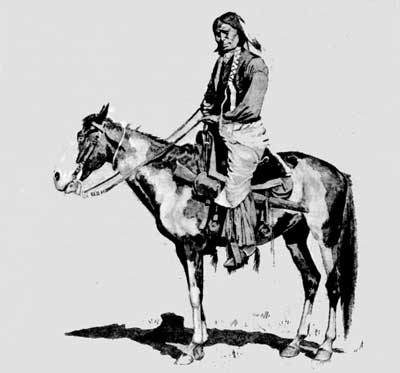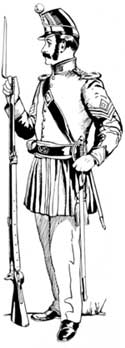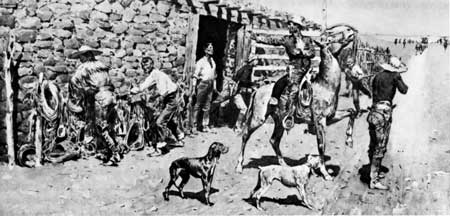|
FORT DAVIS National Historic Site |
 |

A Comanche Warrior, by Frederic Remington
Before their conquest in 1875, the Comanches regularly raided
deep into Mexico and en route frequently attacked travelers on the El Paso
road.
Denver Public Library
Guarding the El Paso Road
 Regulations prescribed this uniform for infantrymen in the 1850's. From an 1856 inspection report it is evident that few soldiers at remote Fort Davis even possessed an entire uniform, much less wore it in the arduous scouting on the deserts of West Texas. |
GENERAL SMITH HAD NO SOONER returned to San Antonio in the autumn of 1854 than he mapped a campaign against the Mescalero Apaches. Under Maj. John S. Simonson, three companies of the Regiment of Mounted Riflemen and three companies of Texas mounted militia reached Fort Davis in December. A company of the 8th Infantry joined them there, and the expedition plunged into the deserts west of the Davis Mountains. For 3 months, as the command marched and countermarched in an attempt to catch the elusive Apaches, Fort Davis served as a supply center and communications link with San Antonio. Although Major Simonson fought few engagements, his energetic scouting caused the Indians to withdraw northward into New Mexico, where many were rounded up by other troops and concentrated on a reservation near newly established Fort Stanton. A few bands continued to live in the Guadalupe and Davis Mountains and in the Big Bend. The menace had not been destroyed, and the Mescaleros returned to haunt the El Paso road.
It soon became obvious that the one post between Forts Clark and Bliss could not effectively police a 400-mile stretch of road. Others were built: Fort Lancaster in 1855, Fort Hudson in 1857, Fort Quitman in 1858, and Fort Stockton in 1859. Mounted on mules, the garrisons of these posts spent most of their time in the arduous duty of escorting mail and freight trains, pursuing but rarely catching Apaches or Comanches, and covering their sector with patrols designed to keep track of Indian movements. Occasionally there was action, but it involved small numbers on both sides and produced no headlines in eastern newspapers.
A typical encounter occurred in July 1857 when a party of about 80 Apaches swept down on the monthly military express bound from San Antonio to Fort Davis just after it crossed the Pecos River. The infantry escort made a brief defense, but when the ranking sergeant was killed, the men abandoned the wagons and fled back to Fort Lancaster. Lt. Edward L. Hartz and 40 men from Fort Davis happened to be at Lancaster. Joined by an officer and another 40 men, Hartz loaded his command in wagons, drew the canvas covers, and set forth on the road to Fort Davis under the guise of a provision train. About 45 miles west of Lancaster, the Indians attacked. The infantrymen piled out of the wagons and shattered the charge with musketry, then spread out as skirmishers. The Indians pulled back out of range and fired the prairie. The troops moved with their wagons into a depression free of grass, and the flames swept past them. Again they advanced with rifles blazing, and the Indians gave up the contest and scattered.

An Overland Station: Indians Coming in With the Stage, by Frederic Remington
The coaches operating on the route through Fort Davis were often attacked by
Comanches and Apaches. Guarding the mail stations was a continuing duty for
the garrison.
Denver Public Library

|
| History | Links to the Past | National Park Service | Search | Contact |
|
Last Modified: Fri, Oct 18 2002 10:00:00 pm PDT |


